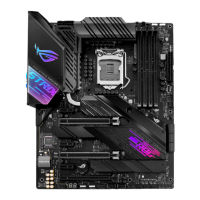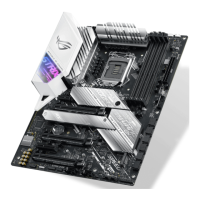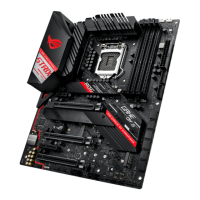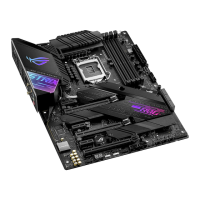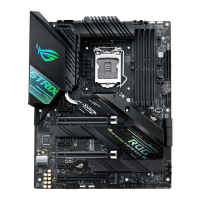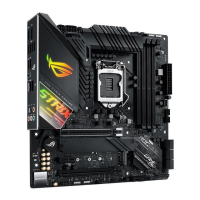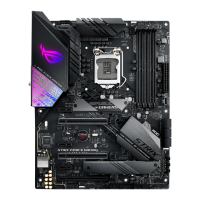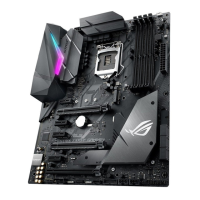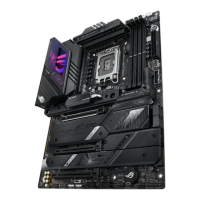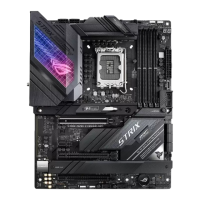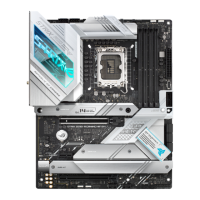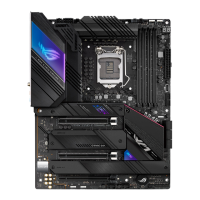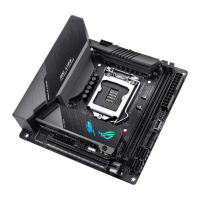
Do you have a question about the Asus ROG STRIX Z490-I GAMING and is the answer not in the manual?
| Form Factor | Mini ITX |
|---|---|
| Socket | LGA 1200 |
| Chipset | Intel Z490 |
| Memory Slots | 2 x DIMM |
| Max Memory Capacity | 64 GB |
| PCIe Slots | 1 x PCIe 3.0 x16 |
| Storage Interfaces | 2 x M.2, 4 x SATA 6Gb/s |
| RGB Lighting | Aura Sync RGB |
| USB Ports | USB 3.2 Gen 2, USB 3.2 Gen 1, USB 2.0 |
| Audio | ROG SupremeFX High Definition Audio CODEC S1220A |
| Networking | Intel I225-V 2.5Gb Ethernet |
| Power Connectors | 1 x 24-pin, 1 x 8-pin |
Details ASUS's commitment to providing source code for GPL/LGPL licensed software included in the product.
Precautions to prevent electrical shock hazards during system handling and operation.
Guidelines for safe installation and operation of the motherboard and components.
Outlines the structure of the manual, detailing its chapters and conventions used.
Summarizes CPU socket, chipset, memory support, and graphics output specifications.
Details expansion slots, storage interfaces (M.2, SATA), Ethernet, and wireless capabilities.
Lists rear panel I/O ports, internal headers for fans, power, and other features.
Covers software features, BIOS details, manageability, OS support, and physical dimensions.
Illustrates connectors and explains bandwidth sharing between M.2_2 and SATA_2.
Lists all items included in the motherboard package, such as cables and documentation.
Displays images and names of tools and components needed for installation, not included.
Provides essential safety guidelines to follow before installing components or changing settings.
Visual guide to the motherboard, labeling key connectors and components.
Detailed list and page references for each numbered component in the layout diagram.
Instructions and precautions for installing the LGA1200 CPU into the motherboard socket.
Explains the DDR4 DIMM slots and guidance on memory module installation.
Details supported memory sizes, dual-channel configuration, and compatibility recommendations.
Describes PCIe expansion slots and their configurations, including for Hyper M.2 cards.
Details the function and specifications of CPU, AIO pump, and chassis fan headers.
Explains how to connect the motherboard to the power supply unit using ATX connectors.
Instructions for installing M.2 SSD modules, including support for PCIe and SATA modes.
Details SATA port usage for connecting storage devices and RAID configuration options.
Explains the front panel connector for USB 3.2 Gen 2 ports and its capabilities.
Describes the header for connecting additional USB 3.2 Gen 1 ports and their speed.
Details the USB 2.0 header and warns against connecting incompatible cables.
Explains connection for addressable RGB LED strips and power limits.
Details connection for standard RGB LED strips and power ratings.
Explains how to use the Clear CMOS header to reset BIOS settings.
Connects the chassis' front panel audio module for HD Audio output.
Connects LED strips to the M.2 heatsink cover, with alignment precautions.
Describes headers for power LEDs, HDD activity, speaker, power button, and reset button.
Connects sensors to monitor component temperatures.
Explains the function of Q-LEDs for checking key components during boot-up.
Introduces the steps for assembling a PC system using the motherboard.
Step-by-step guide and precautions for installing the CPU into the socket.
Detailed steps for mounting the CPU heatsink and fan, including thermal paste application.
Instructions for installing an All-In-One (AIO) liquid cooler.
Guides on how to install and remove RAM modules from the DIMM slots.
Comprehensive instructions for installing M.2 SSDs, covering various steps and precautions.
Steps for physically mounting the motherboard into the PC case using screws.
Illustrates how to connect the main ATX power cables to the motherboard.
Shows how to connect SATA data and power cables to storage devices.
Guides for connecting front panel USB, audio, and speaker headers to the motherboard.
Instructions for installing expansion cards like graphics cards into PCIe slots.
Details on connecting the Wi-Fi antennas to the motherboard's rear panel.
Explains how to update the BIOS using the BIOS FlashBack™™ feature without entering the system.
Identifies and describes all ports located on the motherboard's rear panel.
Details the color-coded audio jacks and their corresponding channel configurations.
Guides on initial system startup procedures and power-on sequence.
Lists BIOS beep codes and their corresponding error descriptions for troubleshooting.
Introduces the ASUS UEFI BIOS interface and its features.
Explains how to enter and use the BIOS setup utility, including modes and basic operations.
Describes the EZ Update utility for updating BIOS within Windows.
Details the ASUS EZ Flash 3 feature for updating BIOS directly from the BIOS setup.
Explains how to recover a corrupted BIOS using the CrashFree BIOS 3 utility.
Defines RAID levels (0, 1, 5, 10) supported by the motherboard and their use cases.
Details the FCC compliance statements for the device and its components.
Provides compliance statements for Canada (ISED), Japan (VCCI), and Korea.
Contains wireless compliance statements for Taiwan and RF equipment regulations for Japan.
Lists important safety precautions for using the device in various environments and situations.
Covers compliance with EU REACH, RoHS, and environmental regulations for India, Vietnam, and Turkey.
Information on ASUS's environmental commitment to recycling and product takeback programs.
States the California warning regarding cancer and reproductive harm associated with the product.
Provides simplified EU declarations of conformity in various languages.
Continues EU declarations and lists Wi-Fi/Bluetooth output power specifications.
Provides contact information for ASUS technical support and general inquiries across different regions.
